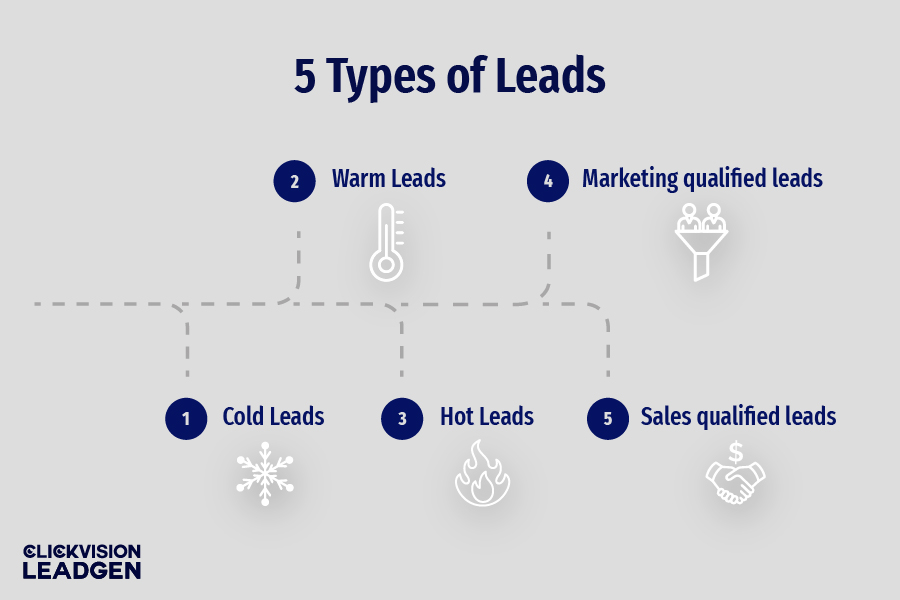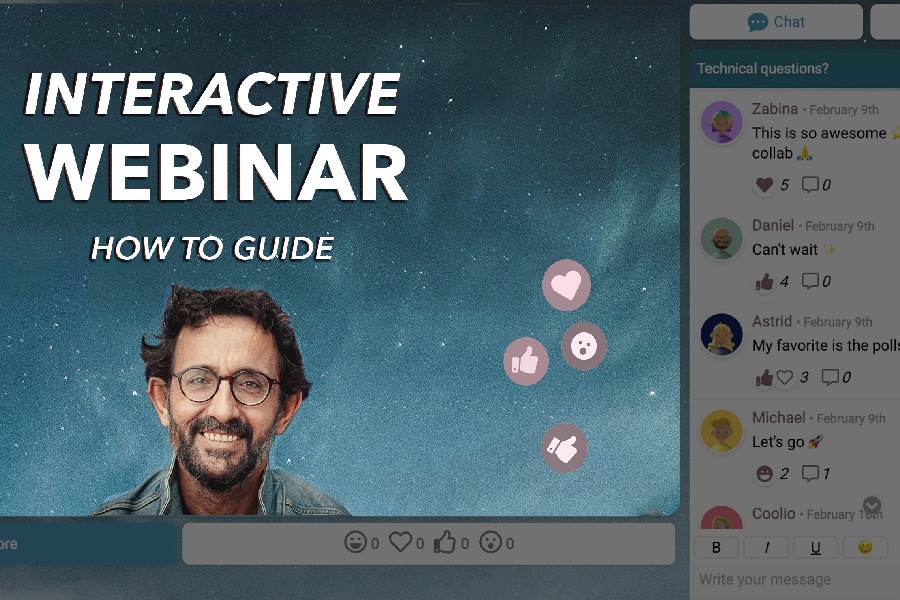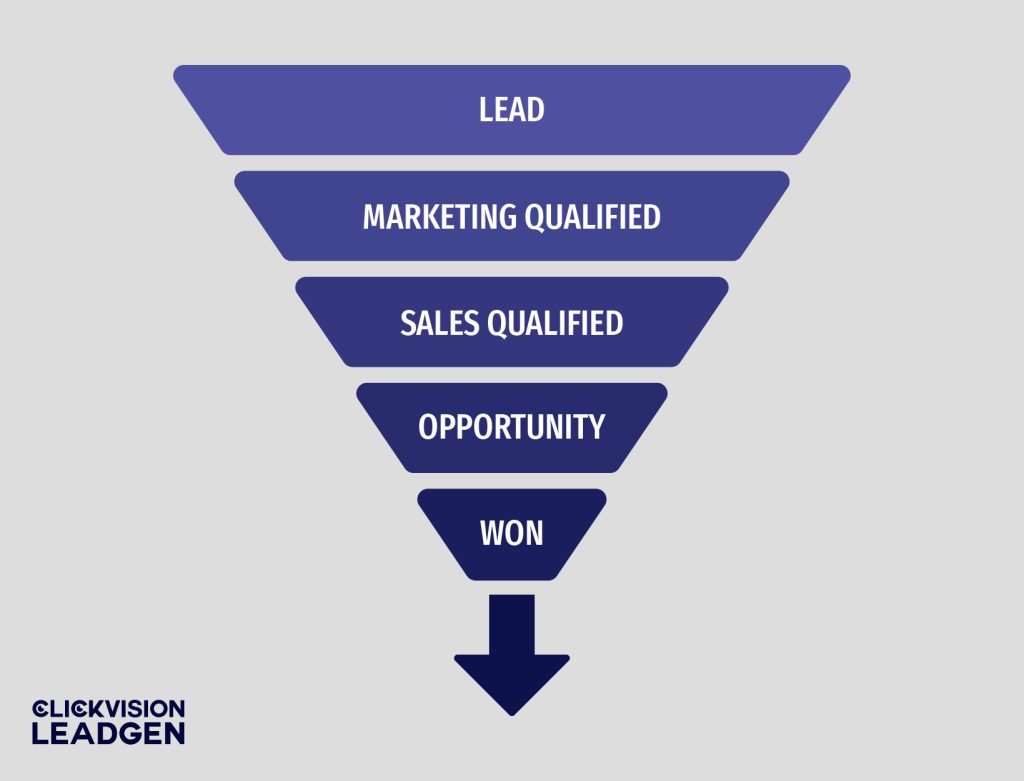In today’s dynamic environment, lead generation has become a critical part of any organization seeking to boost its marketing efforts and drive growth. If you want to expand your business’s outreach and performance quickly, it’s essential to start generating leads effectively. However, achieving this requires a thorough and comprehensive understanding of the various types of leads that can be targeted.
Ahead, we’ll talk about the five main lead types in sales and marketing, detailing their unique characteristics and diverse opportunities. Additionally, we’ll equip you with the best practices for transforming each lead across the spectrum of lead generation channels to maximize conversion rates and ROI.
What Are Leads?
Leads represent potential customers who express interest in a product, service, or offer your company provides. You can attract leads by engaging potential customers in interactions like webinars, sign-ups, or participating in free trials or demos. However, in the process, they provide their contact information, whether emails or phone numbers, presenting opportunities for conversion through targeted marketing efforts.
Essentially, the types of leads greatly depend on your collection methods, impacting the return on investment (ROI) based on audience targeting accuracy. Maximizing ROI from diverse sales funnels and marketing campaigns requires acquiring the appropriate leads. So, understanding the different types of leads and their significance is critical for optimizing strategies and reaching the desired outcomes in sales and marketing efforts.
Luckily, that’s exactly what CLICKVISION Lead Gen specializes in. Our team of experts excels at inbound lead generation through SEO. We rank local websites to attract visitors actively searching for specific services, capturing high-quality leads and delivering unparalleled results to our clients, ensuring higher engagement and conversion rates.

Types of Leads
Generally, there are five main types of leads in the context of sales and marketing, including:
- Cold leads
- Warm leads
- Hot leads
- Marketing qualified leads (MQLs)
- Sales qualified leads (SQLs)
Below, we’ll elaborate on each type, explain their characteristics, and offer the best practices for transforming them across the spectrum of lead generation channels.
1. Cold leads
Cold leads are individuals or businesses that fit in your ideal customer profile perfectly but have had no prior engagement or interest in your business. Cold leads are the most difficult prospects to turn into leads as they’re unaware of who you are and your company, products, or services. Plus, the initial outreach is often perceived as unsolicited, leading to low or no engagement. These leads typically require significant efforts to convert into prospects and involve a lengthy and consistent nurturing process.
The best way to approach cold leads is to nurture them to the top-of-funnel tunnel through writing relevant content or cold calling or emailing.
Other practices you may employ for converting cold leads into customers may include:
- Crafting an email introduction that clearly states your value proposition
- Using specific data about leads to personalize and tailor your outreach, making it more relevant and engaging
- Leveraging social media platforms to build relationships and connect with the public
- Using the cold calling strategy to reach out to prospective customers via a phone call allows you to learn about the prospect’s interest and pitch the company’s product and service in the best way possible.
Caller: Good morning, speaking with [Prospect’s Name]?
Prospect: Yes, who’s calling?
Caller: Hi [Prospect’s Name], it’s [Your Name] from [Your Company]. How are you today?
Prospect: Doing fine, thanks. What’s up?
Caller: We offer [product/service] that benefits businesses like yours. Can I discuss how it could help?
Prospect: Not sure we’re interested.
Caller: Can I email you more info?
Prospect: Okay.
Caller: What’s your email?
Prospect: [Prospect’s Email].
Caller: Thanks, I’ll send it shortly. Any questions, feel free to ask. Have a good day!
Prospect: You too, bye.
2. Warm leads
Warm leads are individuals or businesses who have not yet shown interest in the product you offer but know a lot about your company and the services or products you offer. Unlike cold leads, these leads have engaged with your brand, whether through content interactions, free trials, demos, downloads, or website sign-ups, indicating a higher potential for conversion.
Cultivating relationships with warm leads is significantly easier with the right outreach approach, as they’ve already warmed up to your brand and recognized the value you bring to the table. Here are some of the most effective strategies for converting these leads:
- Personalized engagement – Tailor emails with relevant offers and avoid generic messages.
- Exclusive promotions – Provide VIP treatment with exclusive content, early access, or time-limited discounts to encourage engagement and purchases.
- Interactive webinars or events – Use webinar landing pages to engage and attract warm leads and host interactive events to build strong relationships, turning them into valuable prospects.
- Free trials or demos – Allow warm leads to experience your offers firsthand.
- Call-to-action (CTA) buttons – prompts that indicate the potential lead to take some specified action.
Lastly, consider collecting warm leads when you’ve established a strong online presence and potential customers are engaging with your content.

3. Hot leads
Hot leads are individuals or prospects who have a clear interest and engagement with your brand, demonstrating readiness in making a purchase in the near future. These leads actively seek information and engage with your content, whether through participating in product demos or expressing intent to buy. Their readiness to capitalize on the value of your business provides an excellent opportunity for immediate conversion, demanding proactive approaches to maximize output and prevent lead loss.
Some methods to convert hot leads and capitalize on these opportunities involve:
- Offering instant assistance through real-time chat support by addressing any questions, concerns, or requirements. This helps you guide hot leads toward a quick purchase decision.
- Presenting time-limited offers or discounts relative to specific interests of hot leads and highlighting exclusive opportunities to promote a sense of urgency.
- Ensuring you have an established hassle-free and seamless check-out experience, preventing potential sudden drop-offs.
- Establishing responsive follow-ups, expressing appreciation highlighting the urgency of finalizing the purchase, and implementing email automation for effective processes.
- Since hot leads are more likely to convert, offer added bonuses like free resources, discounts, or free shipping.
- Provide easy and flexible payment options to ensure a seamless transaction process, reducing potential obstacles or challenges.

4. Marketing qualified leads (MQLs)
Similar to warm leads, marketing qualified leads (MQLs) are potential customers who have shown interest in your company’s products or services through specific interaction with marketing efforts. This could include:
- Clicking on targeted ads
- Actively participating in social media campaigns
- Engaging with promotional emails
- Subscribing to newsletters
- Attending webinars
This means that MQLs are potentially ready for sales engagement. To reinforce these opportunities and effectively engage and nurture these leads, you should employ the following strategies and techniques:
- Interactive webinars – establish webinars that provide in-depth insights and address specific concerns regarding your product or services.
- Content hubs – create content hubs where MQLs can access curated information, ensuring alignment with their preferences.
- Personalized email sequences – based on the interests of MQLs, craft emails that offer relevant content that guides them through purchasing processes.
By following these guidelines, you can ensure your targeted marketing efforts are directed toward individuals more likely to convert, enhancing engagement and conversion rates.

5. Sales qualified leads (SQLs)
Sales qualified leads (SQLs) represent potential customers who have progressed through sales funnels, demonstrating immediate engagement and meeting predetermined criteria set by the sales team. They’re people that have shown great interest in your product or service and are those your company has decided are worthy of marketing to.
SQLs are identified based on their engagement level, such as interacting with sales content and high-intent actions, as well as a clear understanding of their needs. While SQLs do indicate readiness for direct sales endeavors, it’s critical to analyze and understand these leads and the collaboration among marketing and sales in lead qualification to close off deals. Some of the best strategies to do so include:
- Establish a conclusive sales approach by actively listening to SQLs’ needs and aligning your product strengths with their preferences.
- Share success stories of similar SQLs to build confidence and trust, reinforcing positive outcomes.
- Create a sense of urgency with limited offers and encourage timely decision-making for exclusive benefits
- Maintain clear and transparent communication in closing processes, ensuring the SQLs feel confident, valued, and well-informed.

Which Leads Should You Focus On?
Determining which type of leads you should focus on typically requires a nuanced understanding of your organizational objectives and various factors like engagement level, alignment with business goals, and the potential for conversion. While there isn’t one specific type of lead that needs special attention, there are scenarios where it’s beneficial to spend the bulk of your energy toward particular leads.
For instance, hot leads showing significant engagement and alignment with business objectives are often prioritized due to their potential for substantial conversion. While they might seem worth the effort, it’s crucial to recognize the value in all types of leads within the sales funnel. As each type plays a critical role in the conversion process, you must establish a balanced approach to ensure a multi-faceted sales strategy for maximized conversion.
So, whether they’re hot leads ready for immediate conversion or cold leads requiring more effort and planning, by investing energy in transforming leads across the spectrum, you can address various engagement levels and conversion readiness. Ultimately, a comprehensive approach is essential for tending to all leads and ensuring a robust and adaptable strategy.

What Is Lead Nurturing?
Essentially, lead nurturing is the process of developing relationships with prospects who are not yet ready to purchase. It involves providing relevant content, such as technical briefs, ebooks, and webinars, tailored to the potential customers’ profile and progression within the sales funnels.
What makes lead nurturing paramount is that it presents your opportunity to provide value to your leads and prospects, helping them grow with your business. So, delivering valuable information for decision-making is paramount, as it ensures that prospects progress through each sales funnel at a natural pace. It ultimately enhances the effectiveness of lead management.
Moreover, automated technologies streamline lead nurturing by enabling real-time tracking, content delivery, as well as behavior and interaction analytics. By utilizing advanced tools and softwares, CLICKVISION Lead Gen offers innovative solutions and tailored approaches to maintain continuous engagement and refine communication based on prospects’ actions and profiles. With our deep understanding of lead nurturing practices, we guarantee increased conversion rates and maximized revenue opportunities.
Conclusion
Leads are potential customers who have shown interest in a product or service your company offers and engagement with your brand’s marketing efforts. They come as cold, warm, and hot, as well as marketing-qualified leads and sales-qualified leads. Each of these types of leads represents differing characteristics and demonstrates their readiness to complete a purchase.
Understanding the varying types of leads is critical for any organization seeking effective targeting efforts and maximizing revenue capture. However, in this process, lead nurturing plays a valuable role, allowing companies to engage prospects with relevant content and guiding them through their progression in sales funnels until they’re prepared to close a deal.
By focusing on the right leads and implementing a robust and adaptable multi-faceted sales strategy, you can optimize their resources and achieve your sales goals more efficiently.

Dimitar is a seasoned marketing specialist and the visionary behind CLICKVISION. With over 10 years in digital marketing, he excels in crafting marketing strategies that boost rankings, which in return increase leads, conversions, sales, profits, and ROI.
